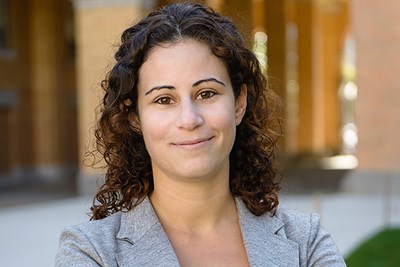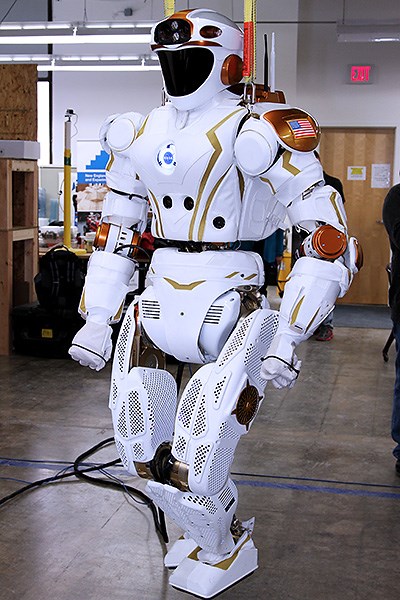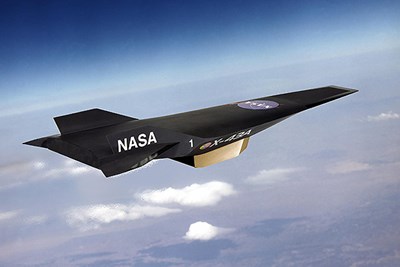UMass Lowell engineering professor's robotics and composite materials research win $1M in funding
Yan Gu and Marianna Maiaru awarded early CAREER grants by the NSF, Air Force
Two researchers from the Department of Mechanical Engineering – Asst. Profs. Yan Gu and Marianna Maiaru – were recognized by the National Science Foundation (NSF) and the U.S. Air Force, respectively, with faculty early career development grants totaling $1,015,000. The funding will help advance research on robot walking and the process modeling of composite materials.
Gu received a five-year NSF CAREER grant, worth nearly $565,000, for research that would develop new methods in modeling, analyzing and controlling the movement of legged robots to keep them stable and upright while walking on nonstationary surfaces.
The CAREER grant is the NSF’s most prestigious award in support of early-career faculty who demonstrate strong potential to lead research breakthroughs in their organizations.
Maiaru’s three-year, $450,000 Young Investigator Program (YIP) grant from the Air Force Office of Scientific Research will support her work to advance the development and processing of high-strength, high-temperature structural materials for the next generation of aerospace vehicles.

The Air Force awards the grant to faculty researchers who “show exceptional ability and promise” in conducting creative, fundamental research in science and engineering.
Maiaru is one of two UML faculty researchers who have won YIP grants. Physics Asst. Prof. Archana Kamal also won the award for her research on quantum information processing.
They are among the 36 scientists and engineers from 27 research institutions across the country selected by the Air Force for the recognition. Aside from UMass Lowell, the other awardees include researchers from Johns Hopkins University, Carnegie Mellon University, Stanford University, Virginia Tech, the University of Illinois at Urbana-Champaign and the University of California San Diego.
Legged Robot Locomotion
Using her CAREER grant, Gu will draw upon dynamic modeling, state estimation, feedback control and theory of hybrid systems to advance the control theory of legged robots in order to realize and prove stable, legged locomotion on dynamic rigid surfaces – that is, surfaces that move but do not deform.

While today’s legged robot systems have shown remarkable capabilities in traversing stationary surfaces like stairs, ramps and sandy or grassy ground, walking on moving rigid surfaces, such as the pitching and rolling decks of ships and rocking floors of aircraft and trains, has not been addressed fully, according to Gu.
“Empowering legged robots with such new functionality will allow them to negotiate complex, dynamic human environments, which are very challenging for robots equipped with wheels or tracks,” Gu explains.
“This will enable them to assist in critical, high-risk situations such as fighting fire aboard ships as well as cleaning and disinfecting public transportation vehicles to contain the spread of infectious diseases such as COVID-19,” she says.
In addition to the CAREER grant, Gu has also received NSF funding for other projects. In 2019, she was awarded a three-year grant totaling nearly $384,000 to control a robot’s movement in various stationary surroundings. The goal is to improve the robot’s capabilities, safety and reliability, especially in conducting search-and-rescue tasks and emergency response, as well as home assistance and health care.
Since last year, Gu has been collaborating with Computer Science Prof. Holly Yanco and Physical Therapy and Kinesiology Asst. Prof. Pei-Chun Kao on a three-year grant worth more than $628,000 to use fabric-embedded sensors to measure the fatigue and endurance of people wearing an exoskeleton. The technology can be applied to help patients with physical disabilities or degenerative diseases such as multiple sclerosis.
Faster than the Speed of Sound
Maiaru’s YIP project focuses on ceramic matrix composite (CMC) materials, which consist of reinforcing ceramic fibers embedded in a ceramic matrix. They are used for high-temperature, high-strength applications, such as components for gas turbines and heat shields for hypersonic aircraft, missiles, rockets and spacecraft.

For example, a vehicle flying through the atmosphere at hypersonic speeds (more than five times the speed of sound, or about 4,000 miles per hour) will experience surface heating of up to 2,700 degrees Fahrenheit due to friction with air molecules. The vehicle’s CMC heat shield is designed to withstand extreme temperature, thermal shock and vibrations during flight.
Maiaru will use experimentally validated process modeling to understand the mechanisms for the formation of residual stress induced by “pyrolysis-infiltration-pyrolysis” processes. Pyrolysis is the degradation of the ceramic at high temperatures in the absence of oxygen.
“My goal is to establish a correlation between processing conditions, microstructure and mechanical performance of the composite, which currently is not clearly shown,” she says. “This work strongly supports ongoing research efforts at the Air Force Research Laboratory and NASA’s Langley Research Center.”
According to Maiaru, process modeling for CMCs manufactured through the pyrolysis-infiltration-pyrolysis cycle is a relatively undeveloped field.
“This project will help enhance the performance of high-temperature composites, optimize their manufacturing process and lead to the discovery of new materials that would establish U.S. leadership in hypersonic applications,” she says.
“It has great potential for advancing materials research for extreme environments and for overcoming the costly and time-consuming trial-and-error design that is being used today.”
Maiaru is currently working on process modeling of advanced composites for structural applications under the sponsorship of the NSF, NASA and the Air Force Research Laboratory.